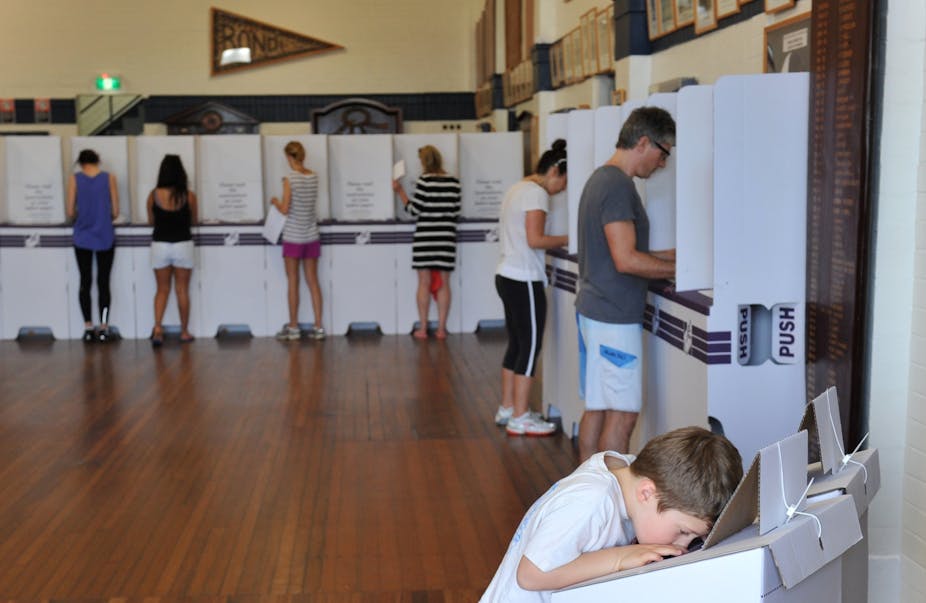This week, a lone High Court judge faced a table of 13 barristers to begin resolving the Western Australian Senate election quandary. The hearing took two days and a judgment is likely sooner or later in February.
There are two realistic outcomes. One is that the election will soon be declared void. The other is that the case will continue, with further legal argument and the parties scrapping over disputed ballots in the coming weeks or months. That could end in a fresh election still being required, or with the original result of three Liberal, two Labor and one Palmer United Party (PUP) senators reinstated.
The result in WA is in doubt because of a combination of two problems. One was the flap of a butterfly’s wings; the other an elephant’s tread. Each was a matter of fate, not skullduggery. But together they are likely to be fatal to the election.
The butterfly effect
The butterfly effect was how the votes panned out. At the key point in the exclusion of microparty candidates, barely a dozen votes out of 1.3 million made the difference to the final two seats. In the original count, a PUP candidate and a second Labor senator were elected.
Given the butterfly effect, the Electoral Commissioner agreed to the Greens’ request for a recount. In that recount, over 3900 votes were reallocated. That is a natural part of the process of carefully re-scrutinising paper ballots.
But the recount miscarried when over 1300 votes from outlying areas were lost, probably in transit. If we factored in the evidence from the original but untested count of the missing votes, only one vote will make the difference in the fork in the road, in favour of Labor and the PUP. The incomplete recount, however, elected senators from the Greens and the Australian Sports Party. Alongside this Gordian knot sit several hundred disputed ballots from the recount.
Off then to the High Court. Sorely embarrassed, the Australian Electoral Commission (AEC) hurried to petition the Court of Disputed Returns. This rarely used mechanism dates to the 1860s in England and Australia. Before that, parliamentary committees decided election disputes. The court can confirm or overturn an election, and then declare someone else elected or require a fresh election.
The parties’ arguments
The AEC argues that a fresh election must be held, a result it wants to be reached cleanly and soon, without further hearings. It says that the purpose of a recount or a court hearing is to scrutinise and rule on all potentially disputed ballots. With 1300 votes missing that cannot occur.
The AEC argues that the lost ballots mean those electors were “prevented from voting”, in the sense of having their vote treated the same as the others (counted, then recounted and scrutinised fully).
Only the Greens agree with that line of reasoning. To their credit, the Greens are not trying to argue that they should keep their seat regardless of the uncertainty. The Sports Party, incredibly, is arguing that it and the Greens should keep their seats even though they “won” them on a recount with a 1300 vote hole in it.
The Liberal Party is keenest to avoid a re-election. With the Abbott government polling poorly, this is understandable. The Liberals feel it is unfair that their three clearly elected senators should have to stand for re-election. They argue that the 1300 electors were not “prevented from voting”. They cast their ballots and there is evidence of their intention from the original tally.
Both Labor and the PUP argue that the original result should be reinstated in their favour. Those parties also want the court to rule afresh on several hundred disputed ballots, some of which they hope to end up on their side of the butterfly’s wings. If not, their seats are won with a bare one-vote fork in the path. Labor is also sanguine with a fresh election.
The case for a fresh election
So, can the court unscramble this egg? A statistician may argue that it can cut the 1300 votes from the original count, paste that tally into the recount, then rule on the disputed ballots. This may take many weeks and it may lead to a result on a thread, but it is a possible salvage job.
As a matter of pragmatics and principle, the right decision is a fresh election.
The pragmatics are mixed. A fresh election is costly: according to one estimate, a fresh election has the potential to cost upwards of $A11 million.
And in the hoopla of a new election, the ballot will be flooded by microparties and even independents from interstate. But if a final count is patched together, it will have seesawed across the margin of error, with no way to know if close scrutiny of the lost votes would have made a difference.
At the bar table in this case are five self-interested political parties, plus the AEC. The AEC has no interest in the outcome. It has already given a big public “mea culpa”. If anything, it should prefer to avoid the cost and ignominy of having to re-run the election.
The public interest is simple: given the mathematical doubt and the irretrievable public distrust in this particular election, the people of WA ought vote afresh.
Beyond that, this is Australia’s “hanging chad” moment. Calls will be made for everything from computerised voting to eliminating microparties and preference deals.
Close elections are an occasional fact of life; butterfly moments are unavoidable. There is no perfect system in an event as complex as an election in a country as big as Australia. Disputes and human error can be minimised but not wished away.

